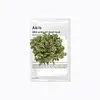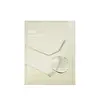What's inside
What's inside
 Key Ingredients
Key Ingredients

 Benefits
Benefits

 Concerns
Concerns

 Ingredients Side-by-side
Ingredients Side-by-side

Water
Skin ConditioningGlycerin
HumectantDipropylene Glycol
HumectantAnastatica Hierochuntica Extract
AstringentPropanediol
SolventPentylene Glycol
Skin ConditioningChlorella Vulgaris Extract
Skin ConditioningPortulaca Oleracea Extract
Skin ConditioningLactobacillus Ferment
Skin ConditioningCynanchum Atratum Extract
Skin ConditioningAlthaea Rosea Flower Extract
Skin ConditioningSodium Hyaluronate
HumectantHydrolyzed Hyaluronic Acid
HumectantHyaluronic Acid
HumectantCamellia Sinensis Seed Oil
HumectantAvena Sativa Kernel Extract
AbrasiveYeast Ferment Extract
Skin ConditioningCocos Nucifera Oil
MaskingCamellia Oleifera Seed Oil
Skin ConditioningCandida Bombicola/Glucose/Methyl Rapeseedate Ferment
Antimicrobial1,2-Hexanediol
Skin ConditioningButylene Glycol
HumectantGlucose
HumectantFructooligosaccharides
HumectantFructose
HumectantPanthenol
Skin ConditioningDiphenyl Dimethicone
EmollientAllantoin
Skin ConditioningTriethylhexanoin
MaskingCaprylyl Glycol
EmollientPolyglyceryl-10 Laurate
Skin ConditioningTromethamine
BufferingEthylhexylglycerin
Skin ConditioningAdenosine
Skin ConditioningAmmonium Acryloyldimethyltaurate/Vp Copolymer
Dipotassium Glycyrrhizate
HumectantHydrogenated Lecithin
EmulsifyingSodium Phytate
Tocopherol
AntioxidantHydroxypropyltrimonium Hyaluronate
Sodium Acetylated Hyaluronate
HumectantHydrolyzed Sodium Hyaluronate
Skin ConditioningSodium Hyaluronate Crosspolymer
HumectantPotassium Hyaluronate
Skin ConditioningLecithin
EmollientCarbomer
Emulsion StabilisingCaffeine
Skin ConditioningXanthan Gum
EmulsifyingCetearyl Alcohol
EmollientWater, Glycerin, Dipropylene Glycol, Anastatica Hierochuntica Extract, Propanediol, Pentylene Glycol, Chlorella Vulgaris Extract, Portulaca Oleracea Extract, Lactobacillus Ferment, Cynanchum Atratum Extract, Althaea Rosea Flower Extract, Sodium Hyaluronate, Hydrolyzed Hyaluronic Acid, Hyaluronic Acid, Camellia Sinensis Seed Oil, Avena Sativa Kernel Extract, Yeast Ferment Extract, Cocos Nucifera Oil, Camellia Oleifera Seed Oil, Candida Bombicola/Glucose/Methyl Rapeseedate Ferment, 1,2-Hexanediol, Butylene Glycol, Glucose, Fructooligosaccharides, Fructose, Panthenol, Diphenyl Dimethicone, Allantoin, Triethylhexanoin, Caprylyl Glycol, Polyglyceryl-10 Laurate, Tromethamine, Ethylhexylglycerin, Adenosine, Ammonium Acryloyldimethyltaurate/Vp Copolymer, Dipotassium Glycyrrhizate, Hydrogenated Lecithin, Sodium Phytate, Tocopherol, Hydroxypropyltrimonium Hyaluronate, Sodium Acetylated Hyaluronate, Hydrolyzed Sodium Hyaluronate, Sodium Hyaluronate Crosspolymer, Potassium Hyaluronate, Lecithin, Carbomer, Caffeine, Xanthan Gum, Cetearyl Alcohol
Water
Skin ConditioningButylene Glycol
HumectantIsopentyldiol
HumectantGlycerin
HumectantBetaine
HumectantGlycereth-26
HumectantNiacinamide
SmoothingMacadamia Integrifolia Seed Oil
Skin ConditioningMethylpropanediol
Solvent1,2-Hexanediol
Skin ConditioningAnastatica Hierochuntica Extract
AstringentCollagen Extract
Skin ConditioningChondrus Crispus Powder
AbrasiveCeratonia Siliqua Gum
EmollientSodium Hyaluronate
HumectantKaolin
AbrasiveHydroxyacetophenone
AntioxidantGlyceryl Stearate
EmollientHydrogenated Coco-Glycerides
EmollientPolysorbate 20
EmulsifyingPolyacrylate-13
Allantoin
Skin ConditioningPropanediol
SolventGlucomannan
Skin ConditioningPanthenol
Skin ConditioningCellulose Gum
Emulsion StabilisingPolyisobutene
Octyldodeceth-16
EmulsifyingAdenosine
Skin ConditioningPotassium Chloride
Dextrin
AbsorbentEthylhexylglycerin
Skin ConditioningSodium Phytate
Sorbitan Isostearate
EmulsifyingDipotassium Glycyrrhizate
HumectantSodium Polyacrylate
AbsorbentTrehalose
HumectantTocopherol
AntioxidantCaprylyl Glycol
EmollientCeramide NP
Skin ConditioningPalmitoyl Tripeptide-5
Skin ConditioningCetearyl Alcohol
EmollientXanthan Gum
EmulsifyingWater, Butylene Glycol, Isopentyldiol, Glycerin, Betaine, Glycereth-26, Niacinamide, Macadamia Integrifolia Seed Oil, Methylpropanediol, 1,2-Hexanediol, Anastatica Hierochuntica Extract, Collagen Extract, Chondrus Crispus Powder, Ceratonia Siliqua Gum, Sodium Hyaluronate, Kaolin, Hydroxyacetophenone, Glyceryl Stearate, Hydrogenated Coco-Glycerides, Polysorbate 20, Polyacrylate-13, Allantoin, Propanediol, Glucomannan, Panthenol, Cellulose Gum, Polyisobutene, Octyldodeceth-16, Adenosine, Potassium Chloride, Dextrin, Ethylhexylglycerin, Sodium Phytate, Sorbitan Isostearate, Dipotassium Glycyrrhizate, Sodium Polyacrylate, Trehalose, Tocopherol, Caprylyl Glycol, Ceramide NP, Palmitoyl Tripeptide-5, Cetearyl Alcohol, Xanthan Gum
 Reviews
Reviews

Ingredients Explained
These ingredients are found in both products.
Ingredients higher up in an ingredient list are typically present in a larger amount.
1,2-Hexanediol is a synthetic liquid and another multi-functional powerhouse.
It is a:
- Humectant, drawing moisture into the skin
- Emollient, helping to soften skin
- Solvent, dispersing and stabilizing formulas
- Preservative booster, enhancing the antimicrobial activity of other preservatives
Adenosine is in every living organism. It is one of four components in nucleic acids that helps store our DNA.
Adenosine has many benefits when used. These benefits include hydrating the skin, smoothing skin, and reducing wrinkles. Once applied, adenosine increases collagen production. It also helps with improving firmness and tissue repair.
Studies have found adenosine may also help with wound healing.
In skincare products, Adenosine is usually derived from yeast.
Learn more about AdenosineAllantoin is a soothing ingredient known for its protective and moisturizingg properties. Because of this, it is often added to products with strong active ingredients.
Studies show higher concentrations of this ingredient can promote wound healing.
Though it can be derived from the comfrey plant, allantoin is produced synthetically for cosmetic products to ensure purity.
Learn more about AllantoinAnastatica Hierochuntica Extract is from a plant called the Rose of Jericho. This plane is found in the deserts of the Middle East and North Africa.
Anastatica Hierochuntica Extract has antioxidant properties. Antioxidants help fight free-radicals. Free-radicals are molecules that may damage your skin cells.
Butylene Glycol (or BG) is used within cosmetic products for a few different reasons:
Overall, Butylene Glycol is a safe and well-rounded ingredient that works well with other ingredients.
Though this ingredient works well with most skin types, some people with sensitive skin may experience a reaction such as allergic rashes, closed comedones, or itchiness.
Learn more about Butylene GlycolCaprylyl Glycol is a humectant and emollient, meaning it attracts and preserves moisture.
It is a common ingredient in many products, especially those designed to hydrate skin. The primary benefits are retaining moisture, skin softening, and promoting a healthy skin barrier.
Though Caprylyl Glycol is an alcohol derived from fatty acids, it is not the kind that can dry out skin.
This ingredient is also used as a preservative to extend the life of products. It has slight antimicrobial properties.
Learn more about Caprylyl GlycolCetearyl alcohol is a mixture of two fatty alcohols: cetyl alcohol and stearyl alcohol. It is mainly used as an emulsifier. Emulsifiers help prevent the separation of oils and products. Due to its composition, it can also be used to thicken a product or help create foam.
Cetearyl alcohol is an emollient. Emollients help soothe and hydrate the skin by trapping moisture.
Studies show Cetearyl alcohol is non-toxic and non-irritating. The FDA allows products labeled "alcohol-free" to have fatty alcohols.
This ingredient is usually derived from plant oils such as palm, vegetable, or coconut oils. There is debate on whether this ingredient will cause acne.
Due to the fatty acid base, this ingredient may not be Malassezia folliculitis safe.
Learn more about Cetearyl AlcoholDipotassium Glycyrrhizate comes from licorice root.
Extracts of licorice have demonstrated to have antibacterial, anti‐inflammatory, antiviral, antioxidant properties.
One component, glabridin, has extra potent antioxidant and soothing properties. It has also been found to block pigmentation from UVB rays in guinea pigs.
Licorice Root also contains a flavonoid. Flavonoids are a natural substance from in plants. Flavonoids also have antioxidant properties.
Another component, glycyrrhizin, has been found to have anti-inflammatory and antimicrobial benefits. This may make licorice root extract effective at treating acne. However, more research is needed to support this.
Liquiritin is one of the flavone compounds found in licorice. It has been found to help lighten skin by preventing tyrosinase from reacting with tyrosine. When the two react, protein is converted to melanin. Melanin is the substance in your body that gives your features pigmentation.
Licorice root is native to Southern Europe and Asia. It has been used in traditional Chinese medicine to help with respiratory issues.
Learn more about Dipotassium GlycyrrhizateEthylhexylglycerin (we can't pronounce this either) is commonly used as a preservative and skin softener. It is derived from glyceryl.
You might see Ethylhexylglycerin often paired with other preservatives such as phenoxyethanol. Ethylhexylglycerin has been found to increase the effectiveness of these other preservatives.
Glycerin is already naturally found in your skin. It helps moisturize and protect your skin.
A study from 2016 found glycerin to be more effective as a humectant than AHAs and hyaluronic acid.
As a humectant, it helps the skin stay hydrated by pulling moisture to your skin. The low molecular weight of glycerin allows it to pull moisture into the deeper layers of your skin.
Hydrated skin improves your skin barrier; Your skin barrier helps protect against irritants and bacteria.
Glycerin has also been found to have antimicrobial and antiviral properties. Due to these properties, glycerin is often used in wound and burn treatments.
In cosmetics, glycerin is usually derived from plants such as soybean or palm. However, it can also be sourced from animals, such as tallow or animal fat.
This ingredient is organic, colorless, odorless, and non-toxic.
Glycerin is the name for this ingredient in American English. British English uses Glycerol/Glycerine.
Learn more about GlycerinPanthenol is a common ingredient that helps hydrate and soothe the skin. It is found naturally in our skin and hair.
There are two forms of panthenol: D and L.
D-panthenol is also known as dexpanthenol. Most cosmetics use dexpanthenol or a mixture of D and L-panthenol.
Panthenol is famous due to its ability to go deeper into the skin's layers. Using this ingredient has numerous pros (and no cons):
Like hyaluronic acid, panthenol is a humectant. Humectants are able to bind and hold large amounts of water to keep skin hydrated.
This ingredient works well for wound healing. It works by increasing tissue in the wound and helps close open wounds.
Once oxidized, panthenol converts to pantothenic acid. Panthothenic acid is found in all living cells.
This ingredient is also referred to as pro-vitamin B5.
Learn more about PanthenolPropanediol is an all-star ingredient. It softens, hydrates, and smooths the skin.
It’s often used to:
Propanediol is not likely to cause sensitivity and considered safe to use. It is derived from corn or petroleum with a clear color and no scent.
Learn more about PropanediolSodium Hyaluronate is hyaluronic acid's salt form. It is commonly derived from the sodium salt of hyaluronic acid.
Like hyaluronic acid, it is great at holding water and acts as a humectant. This makes it a great skin hydrating ingredient.
Sodium Hyaluronate is naturally occurring in our bodies and is mostly found in eye fluid and joints.
These are some other common types of Hyaluronic Acid:
Learn more about Sodium HyaluronateSodium Phytate is the synthetic salt form of phytic acid. Phytic acid is an antioxidant and can be found in plant seeds.
Sodium Phytate is a chelating agent. Chelating agents help prevent metals from binding to water. This helps stabilize the ingredients and the product.
Tocopherol (also known as Vitamin E) is a common antioxidant used to help protect the skin from free-radicals and strengthen the skin barrier. It's also fat soluble - this means our skin is great at absorbing it.
Vitamin E also helps keep your natural skin lipids healthy. Your lipid skin barrier naturally consists of lipids, ceramides, and fatty acids. Vitamin E offers extra protection for your skin’s lipid barrier, keeping your skin healthy and nourished.
Another benefit is a bit of UV protection. Vitamin E helps reduce the damage caused by UVB rays. (It should not replace your sunscreen). Combining it with Vitamin C can decrease sunburned cells and hyperpigmentation after UV exposure.
You might have noticed Vitamin E + C often paired together. This is because it is great at stabilizing Vitamin C. Using the two together helps increase the effectiveness of both ingredients.
There are often claims that Vitamin E can reduce/prevent scarring, but these claims haven't been confirmed by scientific research.
Learn more about TocopherolWater. It's the most common cosmetic ingredient of all. You'll usually see it at the top of ingredient lists, meaning that it makes up the largest part of the product.
So why is it so popular? Water most often acts as a solvent - this means that it helps dissolve other ingredients into the formulation.
You'll also recognize water as that liquid we all need to stay alive. If you see this, drink a glass of water. Stay hydrated!
Learn more about WaterXanthan gum is used as a stabilizer and thickener within cosmetic products. It helps give products a sticky, thick feeling - preventing them from being too runny.
On the technical side of things, xanthan gum is a polysaccharide - a combination consisting of multiple sugar molecules bonded together.
Xanthan gum is a pretty common and great ingredient. It is a natural, non-toxic, non-irritating ingredient that is also commonly used in food products.
Learn more about Xanthan Gum